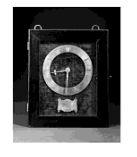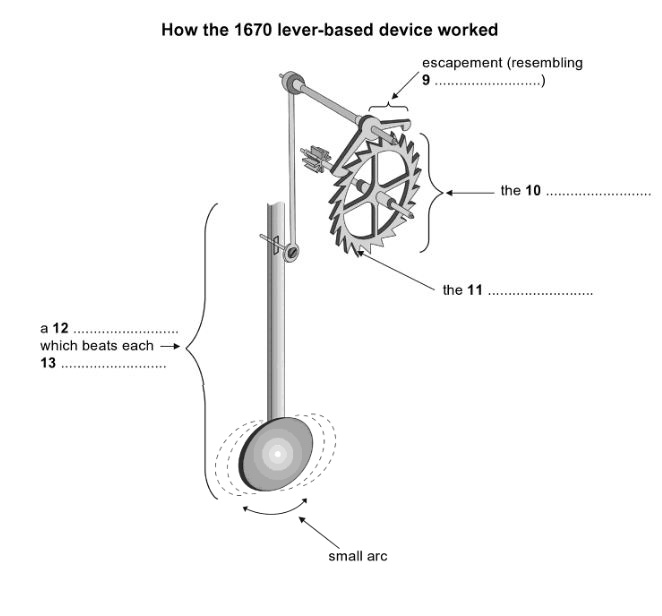DỊCH HOÀN THIỆN ĐỀ THI IELTS READING VÀ GIẢI THÍCH ĐÁP ÁN:
A Chronicle of Timekeeping
Our conception of time depends on the way we measure it.
Khái niệm thời gian chủa chúng ta phụ thuộc vào cách mà chúng ta đó lường nó.

A According to archaeological evidence, at least 5, 000 years ago, and long before the advent of the Roman Empire, the Babylonians began to measure time, introducing calendars to coordinate communal activities, to plan the shipment of goods and, in particular, to regulate planting and harvesting. They based their calendars on three natural cycles: the solar day, marked by the successive periods of light and darkness as the earth rotates on its axis; the lunar month, following the phases of the moon as it orbits the earth; and the solar year, defined by the changing seasons that accompany our planet's revolution around the sun.
Theo bằng chứng khảo cổ học, cách đây ít nhất 5000 năm, và rất lâu trước khi Đế chế La Mã ra đời, người Babylon bắt đầu đo lường thời gian, đưa ra lịch để điều phối các hoạt động cộng đồng, lên kế hoạch vận chuyển hàng hóa và đặc biệt là để điều tiết trồng trọt và thu hoạch. Lịch của họ dựa trên ba chu kỳ tự nhiên: ngày mặt trời, được đánh dấu bằng các khoảng thời gian liên tiếp của ánh sáng và bóng tối khi trái đất quay quanh trục của nó; tháng âm lịch, theo các tuần trăng khi nó quay quanh trái đất; và năm mặt trời, được xác định bởi các mùa thay đổi đi kèm với sự quay vòng của hành tinh trái đất xung quanh mặt trời.
B Before the invention of artificial light, the moon had greater social impact. And, for those living near the equator, in particular, its waxing and waning were more conspicuous than the passing of the seasons. Hence, the calendars that were developed at the lower latitudes were influenced more by the lunar cycle than by the solar year. In more northern climes, however, where seasonal agriculture was practised, the solar year became more crucial. As the Roman Empire expanded northward, it organised its activity chart for the most part around the solar year.
Trước khi phát minh ra ánh sáng nhân tạo, mặt trăng đã có tác động xã hội rất lớn. Và, đối với những người sống gần đường xích đạo, đặc biệt, việc tròn rồi lại khuyết của nó còn dễ thấy hơn cả sự trôi qua của các mùa trong năm. Do đó, các lịch được phát triển ở các vĩ độ thấp hơn bị ảnh hưởng bởi chu kỳ mặt trăng hơn là năm mặt trời. Tuy nhiên, ở những vùng khí hậu lệch về phía bắc hơn, nơi thực hiện nông nghiệp theo mùa, năm mặt trời trở nên quan trọng hơn. Khi Đế chế La Mã mở rộng về phía bắc, họ đã tổ chức biểu đồ hoạt động chủ yếu xung quanh năm mặt trời.
for the most part: mostly or usually
C Centuries before the Roman Empire, the Egyptians had formulated a municipal calendar having 12 months of 30 days, with five days added to approximate the solar year. Each period of ten days was marked by the appearance of special groups of stars called decans. At the rise of the star Sirius just before sunrise, which occurred around the all-important annual flooding of the Nile, 12 decans could be seen spanning the heavens. The cosmic significance the Egyptians placed in the 12 decans led them to develop a system in which each interval of darkness (and later, each interval of daylight) was divided into a dozen equal parts. These periods became known as temporal hours because their duration varied according to the changing length of days and nights with the passing of the seasons. Summer hours were long, winter ones short; only at the spring and autumn equinoxes were the hours of daylight and darkness equal. Temporal hours, which were first adopted by the Greeks and then the Romans, who disseminated them through Europe, remained in use for more than 2500 years.
Nhiều thế kỷ trước Đế chế La Mã, người Ai Cập đã xây dựng lịch đô thị có 12 tháng 30 ngày, với năm ngày được thêm vào để gần đúng với năm mặt trời. Mỗi khoảng thời gian mười ngày được đánh dấu bằng sự xuất hiện của các nhóm sao đặc biệt được gọi là decan. Khi sao Sirius mọc lên ngay trước khi mặt trời mọc, xảy ra xung quanh trận lũ lụt hàng năm quan trọng của sông Nile, có thể nhìn thấy 12 decan trải dài trên bầu trời. Ý nghĩa vũ trụ mà người Ai Cập đặt trong 12 decan đã khiến họ phát triển một hệ thống trong đó mỗi khoảng thời gian tối (và sau đó là mỗi khoảng thời gian ánh sáng ban ngày) được chia thành mười hai phần bằng nhau. Những khoảng thời gian này được gọi là giờ biểu thị vì thời gian của chúng thay đổi theo độ dài ngày và đêm cùng với sự trôi qua của mùa. Giờ mùa hè dài, giờ mùa đông ngắn; chỉ vào thời điểm xuân phân và thu phân thì giờ ánh sáng ban ngày và bóng tối bằng nhau. Giờ biểu thị, được người Hy Lạp áp dụng đầu tiên và sau đó là người La Mã, những người đã phổ biến chúng qua châu Âu, vẫn được sử dụng trong hơn 2, 500 năm.
D In order to track temporal hours during the day, inventors created sundials, which indicate time by the length or direction of the sun's shadow. The sundial's counterpart, the water clock, was designed to measure temporal hours at night. One of the first water clocks was a basin with a small hole near the bottom through which the water dripped out. The falling water level denoted the passing hour as it dipped below hour lines inscribed on the inner surface. Although these devices performed satisfactorily around the Mediterranean, they could not always be depended on in the cloudy and often freezing weather of northern Europe.

1. Mua bộ đề gần 400 bài ielts reading - Dịch và giải chi tiết Chỉ 199k bao gồm toàn bộ đề trong bộ Cambridge ( từ bộ 1 -19) và nhiều đề thi thực tế ( xem danh sách 400 đề ielts reading tại đây). Xem bài mẫu tại đây, Bài mẫu 1, bài mẫu 2, bài mẫu 3. Giải đề bao gồm phần dịch bài đọc, dịch phần câu hỏi, giải thích chi tiết, ( chỉ có thể tải, in phần đề để luyện tập, phần giải chi tiết và dịch chỉ xem online).
>>>>> Đặc biệt tặng kèm Dịch và giải chi tiết bộ đề Ielts listening từ Cam 10-18 và tặng kèm hơn 300 đề Ielts thực tế ( không có lời giải chi tiết chỉ có đề và đáp án) ( khác với bộ 400 đề ở trên). Vui lòng điền thông tin theo form tại đây và thanh toán theo thông tin CK trong form.
2. Đặc biệt dành tặng 100 bạn hoàn thành buổi học thử miễn phí khóa học Ielts Speaking online 1 kèm 1, các bạn sẽ được tặng bộ đề 400k bài Ielts reading và bộ đề Ielts Listening bộ Cam từ 10-18 gồm bài dịch và giải chi tiết, giải thích từ vựng khó ( thời hạn sử dụng trong vòng 2 tháng). Xem thông tin khóa học Ielts Speaking online 1 kèm 1 và đăng ký học thử tại đây.
E The advent of the mechanical clock meant that although it could be adjusted to maintain temporal hours, it was naturally suited to keeping equal ones. With these, however, arose the question of when to begin counting, and so, in the early 14th century, a number of systems evolved. The schemes that divided the day into 24 equal parts varied according to the start of the count: Italian hours began at sunset, Babylonian hours at sunrise, astronomical hours at midday and 'great clock' hours, used for some large public clocks in Germany, at midnight. Eventually, these were superseded by 'small clock', or French hours, which split the day into two 12-hour periods commencing at midnight.
F The earliest recorded weight-driven mechanical clock was built in 1283 in Bedfordshire in England. The revolutionary aspect of this new timekeeper was neither the descending weight that provided its motive force nor the gear wheels (which had been around for at least 1, 300 years) that transferred the power; it was the part called the escapement. In the early 1400s came the invention of the coiled spring or fusee which maintained a constant force to the gear wheels of the timekeeper despite the changing tension of its mainspring. By the 16th century, a pendulum clock had been devised, but the pendulum swung in a large arc and thus was not very efficient.
G To address this, a variation on the original escapement was invented in 1670, in England. It was called the anchor escapement, which was a lever-based device shaped like a ship's anchor. The motion of a pendulum rocks this device so that it catches and then releases each tooth of the escape wheel, in turn allowing it to turn a precise amount. Unlike the original form used in early pendulum clocks, the anchor escapement permitted the pendulum to travel in a very small arc. Moreover, this invention allowed the use of a long pendulum which could beat once a second and thus led to the development of a new floor-standing case design, which became known as the grandfather clock.
H Today, highly accurate timekeeping instruments set the beat for most electronic devices. Nearly all computers contain a quartz-crystal clock to regulate their operation. Moreover, not only do time signals beamed down from Global Positioning System satellites calibrate the functions of precision navigation equipment, they do so as well for mobile phones, instant stock-trading systems and nationwide power-distribution grids. So integral have these time-based technologies become to day-to-day existence that our dependency on them is recognised only when they fail to work.
>>>>> Xem thêm:
♦ Tổng hợp câu trả lời, câu hỏi, từ vựng của hơn 70 chủ đề Ielts Speaking part 1
♦ Tổng hợp gần 400 đề thi Ielts reading ( bao gồm dịch, giải chi tiết, từ vựng)
Questions 1-4
Reading Passage 77 has eight paragraphs, A-H.
Which paragraph contains the following information?
Write the correct letter, A-H, in boxes 1- 4 on your answer sheet.
1 a description of an early timekeeping invention affected by cold temperatures
2 an explanation of the importance of geography in the development of the calendar in farming communities
3 a description of the origins of the pendulum clock
4 details of the simultaneous efforts of different societies to calculate time using uniform hours
Questions 5-8
Look at the following events (Questions 5-8) and the list of nationalities below.
Match each event with the correct nationality, A-F.
Write the correct letter, A-F, in boxes 5-8 on your answer sheet.
5 They devised a civil calendar in which the months were equal in length.
6 They divided the day into two equal halves.
7 They developed a new cabinet shape for a type of timekeeper.
8 They created a calendar to organise public events and work schedules.
|
List of Nationalities |
Questions 9-13
Label the diagram below.
Choose NO MORE THAN TWO WORDS from the passage for each answer.
Write your answers in boxes 9-13 in your answer sheet

ĐÁP ÁN, GIẢI CHI TIẾT và DỊCH HOÀN THIỆN ĐỀ THI IELTS READING:
A Chronicle of Timekeeping
Questions 1-4
Reading Passage 77 has eight paragraphs, A-H.
Which paragraph contains the following information?
Write the correct letter, A-H, in boxes 1- 4 on your answer sheet.
1D a description of an early timekeeping invention affected by cold temperatures
Mô tả về phát minh đồng hồ thuở ban đầu bị ảnh hưởng bởi nhiệt độ lạnh
Giải thích:
Although these devices performed satisfactorily around the Mediterranean, they could not always be depended on in the cloudy and often freezing weather of northern Europe.
2B an explanation of the importance of geography in the development of the calendar in farming communities
Lời giải thích về tầm quan trọng của địa lý trong sự phát triển lịch trong các cộng đồng nông nghiệp
Giải thích:
Hence, the calendars that were developed at the lower latitudes were influenced more by the lunar cycle than by the solar year. In more northern climes, however, where seasonal agriculture was practised, the solar year became more crucial. As the Roman Empire expanded northward, it organised its activity chart for the most part around the solar year.
Questions 5-8
Look at the following events (Questions 5-8) and the list of nationalities below.
Match each event with the correct nationality, A-F.
Write the correct letter, A-F, in boxes 5-8 on your answer sheet.
5B They devised a civil calendar in which the months were equal in length.
Họ nghĩ ra một lịch nội bộ có các tháng có độ dài như nhau
Giải thích: Đoạn C
Centuries before the Roman Empire, the Egyptians had formulated a municipal calendar having 12 months of 30 days, with five days added to approximate the solar year.
6 F They divided the day into two equal halves.
Họ chia ngày thành hai nửa bằng nhau
Giải thích: Đoạn E
French hours, which split the day into two 12-hour periods commencing at midnight.
Questions 9-13
Label the diagram below.
Choose NO MORE THAN TWO WORDS from the passage for each answer.
Write your answers in boxes 9-13 in your answer sheet

9. ship's anchor
10. escape wheel
11. tooth
12. long pendulum
13 second
Giải thích: Đoạn G
To address this, a variation on the original escapement was invented in 1670, in England. It was called the anchor escapement, which was a lever-based device shaped like a ship's anchor Q9. The motion of a pendulum rocks this device so that it catches and then releases each tooth of the escape wheel Q10 & Q11, in turn allowing it to turn a precise amount. Unlike the original form used in early pendulum clocks, the anchor escapement permitted the pendulum to travel in a very small arc. Moreover, this invention allowed the use of a long pendulum Q12 which could beat once a second Q13 and thus led to the development of a new floor-standing case design, which became known as the grandfather clock.
Answer:
1. D 2. B 3. F 4. E 5. B 6. F 7. D 8. A 9. (ship's) anchor / (an/ the) anchor 10. (escape) wheel 11. tooth 12. (long) pendulum 13. second
1. Mua bộ đề gần 400 bài ielts reading - Dịch và giải chi tiết Chỉ 199k bao gồm toàn bộ đề trong bộ Cambridge ( từ bộ 1 -19) và nhiều đề thi thực tế ( xem danh sách 400 đề ielts reading tại đây). Xem bài mẫu tại đây, Bài mẫu 1, bài mẫu 2, bài mẫu 3. Giải đề bao gồm phần dịch bài đọc, dịch phần câu hỏi, giải thích chi tiết, ( chỉ có thể tải, in phần đề để luyện tập, phần giải chi tiết và dịch chỉ xem online).
>>>>> Đặc biệt tặng kèm Dịch và giải chi tiết bộ đề Ielts listening từ Cam 10-18 và tặng kèm hơn 300 đề Ielts thực tế ( không có lời giải chi tiết chỉ có đề và đáp án) ( khác với bộ 400 đề ở trên). Vui lòng điền thông tin theo form tại đây và thanh toán theo thông tin CK trong form.
2. Đặc biệt dành tặng 100 bạn hoàn thành buổi học thử miễn phí khóa học Ielts Speaking online 1 kèm 1, các bạn sẽ được tặng bộ đề 400k bài Ielts reading và bộ đề Ielts Listening bộ Cam từ 10-18 gồm bài dịch và giải chi tiết, giải thích từ vựng khó ( thời hạn sử dụng trong vòng 2 tháng). Xem thông tin khóa học Ielts Speaking online 1 kèm 1 và đăng ký học thử tại đây.

.png)

.jpg)




